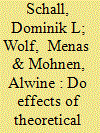|
|
|
Sort Order |
|
|
|
Items / Page
|
|
|
|
|
|
|
| Srl | Item |
| 1 |
ID:
166931


|
|
|
|
|
| Summary/Abstract |
This paper presents a quasi-randomized controlled trial in a workplace with personalized lighting control and investigates the impact of automated demand response (DR) on employees. It also clarifies what type of conditions will make employees participate in DR. To meet this objective, we set up four treatment groups: opt-in performance incentive, opt-in fixed incentive, opt-out performance incentive, and opt-out fixed incentive. In the experiment, the group with the highest participation rate is the opt-out fixed incentive. Subsequently, we estimate two average treatment effects (intent-to-treat and treatment-on-treated) for DR. The results reveal a significant reduction in electricity consumption during peak hours for all four treatment groups. We find that although the DR participation rate is high for the opt-out group, its average energy-saving effect is not significantly different than that for the opt-in group, and the average energy-saving amount of opt-in consumers is larger than that of opt-out consumers. We also show a similar trade-off between the participation rate and the power-saving effect for employees participating in DR.
|
|
|
|
|
|
|
|
|
|
|
|
|
|
|
|
| 2 |
ID:
132597


|
|
|
|
|
| Publication |
2014.
|
| Summary/Abstract |
Incentives are policy tools that sway purchase, retail stocking, and production decisions toward energy-efficient products. Incentives complement mandatory standards and labeling policies by accelerating market penetration of products that are more energy efficient than required by existing standards and by preparing the market for more stringent future mandatory requirements. Incentives can be directed at different points in the appliance×s supply chain; one point may be more effective than another depending on the technology×s maturity and market penetration. This paper seeks to inform future policy and program design by categorizing the main elements of incentive programs from around the world. We identify advantages and disadvantages of program designs through a qualitative overview of incentive programs worldwide. We find that financial incentive programs have greater impact when they target highly efficient technologies with a small market share, and that program designs depend on the market barriers addressed, the target equipment, and the local market context. No program design is inherently superior to another. The key to successful program design and implementation is a thorough understanding of the market and identification of the most important local obstacles to the penetration of energy-efficient technologies.
|
|
|
|
|
|
|
|
|
|
|
|
|
|
|
|
| 3 |
ID:
150023


|
|
|
|
|
| Summary/Abstract |
Increasing energy efficiency is a cornerstone of policy initiatives to tackle climate change and increase corporate sustainability. Convincing people to drive more fuel-efficiently (“eco-driving”) is often an integral part of these approaches, especially in the transport sector. But there is a lack of studies on the long-term persistence and potential interaction of the effects of incentives and training on energy conservation behavior in general and eco-driving behavior in particular. We address this gap with a twelve months long natural field experiment in a logistics company to analyze the time-dependent and potentially interacting effects of rewards and theoretical training for eco-driving on fuel consumption in a real-world setting. We find an immediate reduction of fuel consumption following the introduction of a non-monetary reward and an attenuation of this effect over time. Theoretical eco-driving training shows no effect, neither short-term nor long-term, highlighting the often neglected necessity to include practical training elements. Contrary to common assumptions, the interaction of incentives and theoretical training does not show an additional reduction effect. Our results demonstrate the difficulty of changing engrained behavior and habits, and underline the need for a careful selection and combination of interventions. Policy implications for public and private actors are discussed.
|
|
|
|
|
|
|
|
|
|
|
|
|
|
|
|
| 4 |
ID:
162316


|
|
|
|
|
| Summary/Abstract |
Vehicle taxes and purchase subsidies have been used frequently to provide incentives for electric vehicle adoption. To examine the role of the incentives in reducing total ownership costs of battery electric vehicles (BEVs), increasing BEV sales, and obtaining environmental benefits from switching to BEVs, we carry out cost–benefit analyses and ordinary least square regressions. We study 10 pairs of BEVs and their internal combustion engine vehicle (ICEV) counterparts across 28 European countries from 2012 to 2014. The results show that, under the incentive schemes, the costs reduced by switching to large BEVs from their ICEV counterparts are larger than the costs reduced by switching to small BEVs from their ICEV counterparts. Owing to the cost-reduction effect, a 10% increase of the total tax incentive leads to an increase in the sales share of BEVs by around 3% on average. Finally, we find that it is still costly to use the tax incentives to reduce emissions and other environmental externalities through transport electrification, despite recent improvements in greening electricity generation and lowering battery costs.
|
|
|
|
|
|
|
|
|
|
|
|
|
|
|
|
| 5 |
ID:
187039


|
|
|
|
|
| Summary/Abstract |
What can UN mediators do to bring warring parties to a negotiated settlement? This article – using ripeness theory – focuses on the parties’ incentives to make a policy shift from war to settlement, and mediators’ influence over such incentives. Mediators can influence through utilizing leverage to create incentives by affecting the parties’ perceived relative power, and through applying intangible resources to facilitate incentive creation without affecting perceived relative power. The constraint on UN mediators is their lack of leverage, while their potential lies in their unique repertoire of intangible resources for facilitative influence. A recurrent limitation of UN mediation manifests where state mediators’ manipulative influence is needed to create the parties’ incentives, and UN mediators’ facilitative influence alone is not enough. On the other hand, UN mediatory potential can be utilized where the parties’ incentives are developed through their own actions and often in the face of pressure and leverage from external patrons.
|
|
|
|
|
|
|
|
|
|
|
|
|
|
|
|
| 6 |
ID:
158633


|
|
|
|
|
| Summary/Abstract |
Existing literature on China’s Performance Evaluation System and how it shapes cadre behavior tends to assume a hierarchy of work targets either through the framework of soft targets, hard targets, and priority targets with veto power or through target measurability. However, this traditional conceptualization of target hierarchy can no longer capture the nature of content of today’s Performance Evaluation System nor can it explain cadre behavior under the new economic and political order imposed by Xi Jinping. Based on field research conducted in various administrative level localities of four provinces during 2014, 2016, and 2017, I argue that today’s Performance Evaluation System has evolved into an increasingly balanced system driven by three prevailing features: the diminishing hard/soft targets dichotomy, the much more constrained power of priority targets with veto power, and the comprehensive quantification of evaluation targets. This study contributes to an updated understanding of the incentive mechanism of the Performance Evaluation System and how that can help explain cadre behavior today. The findings of the research have important political and economic implications on the Xi administration and the Communist Party.
|
|
|
|
|
|
|
|
|
|
|
|
|
|
|
|
|
|
|
|
|